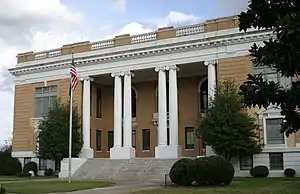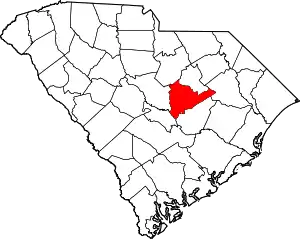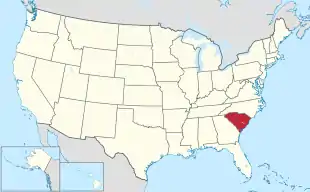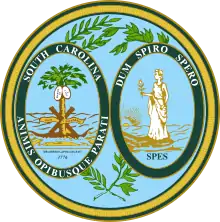Sumter County, South Carolina
Sumter County is a county located in the U.S. state of South Carolina. As of the 2010 census, the population was 107,456. In a 2018 census estimate, the population was 106,512.[1] Its county seat is Sumter.[2]
Sumter County | |
|---|---|
 Sumter County Courthouse, Sumter | |
 Location within the U.S. state of South Carolina | |
 South Carolina's location within the U.S. | |
| Coordinates: 33°55′N 80°23′W | |
| Country | |
| State | |
| Founded | 1800 |
| Named for | Thomas Sumter |
| Seat | Sumter |
| Largest city | Sumter |
| Area | |
| • Total | 682 sq mi (1,770 km2) |
| • Land | 665 sq mi (1,720 km2) |
| • Water | 17 sq mi (40 km2) 2.5%% |
| Population (2010) | |
| • Total | 107,456 |
| • Estimate (2018) | 106,512 |
| • Density | 160/sq mi (61/km2) |
| Time zone | UTC−5 (Eastern) |
| • Summer (DST) | UTC−4 (EDT) |
| Congressional districts | 5th, 6th |
| Website | www |
Sumter County comprises the Sumter, South Carolina Metropolitan Statistical Area, which, combined with neighboring Lee and Clarendon counties, formed the Sumter-Bishopville-Manning Combined Statistical Area, otherwise known as the "East Midlands" area.
It is the home of Shaw AFB, headquarters to the 9th Air Force, AFCENT, United States Army Central, with a number of other tenant units. It is one of largest bases in the USAF's Air Combat Command.
History
Sumter County was created from Clarendon, Claremont and Salem Counties as Sumter District in 1798, named after General Thomas Sumter,[3] and became effective in 1800.[4] When the home of Sumter District's clerk of records burnt in 1801, the formative records of the three predecessor counties were also destroyed in the conflagration.[3] So documentary evidence that the three counties were within St. Mark's Parish (formed in 1757 from Prince Frederick's Parish, Craven County) in Camden District (formed 1769) derives from family genealogies and legislative records.
On 19 December 1855, a legislative act was passed partitioning Sumter District by forming Clarendon District, with the same boundaries as defined for Clarendon County in 1785. When effectuated in 1857, a northeastern part of Sumter District (formerly in Salem County) was also separated in the partition (the area east of a line drawn from the northernmost point of old Clarendon County continued north-northeasterly to a point on the boundary line with Darlington District (Sumter County's northeastern cornerpoint abutting Florence County since 1888).
The Sumter District gained a form of self-rule and was renamed Sumter County under the 1868 Constitution.[5]
In 1898, a northwestern part of Sumter County was detached to form part of the first Lee County, but its formation was declared unconstitutional in 1899. In 1902, an even larger northern part of Sumter County (more or less the remaining part of former Salem County) was properly legally detached to form the major sections of the current Lee County, of which some acreage reverted in 1914.
In 1921 southern Sumter County received a section from Clarendon County, of which some acreage reverted in 1922, creating the current boundaries of Sumter County.
Geography
According to the U.S. Census Bureau, the county has a total area of 682 square miles (1,770 km2), of which 665 square miles (1,720 km2) is land and 17 square miles (44 km2) (2.5%) is water.[6] It is drained by the Black River and its tributaries.[7] Its western border is formed by the Wateree River. One of South Carolina's most famous areas are the High Hills of Santee comprising the western part of the county. The county is one of five that borders Lake Marion, also known as South Carolina's "Inland Sea."
Adjacent counties
- Lee County - north
- Florence County - northeast
- Clarendon County - south
- Calhoun County - southwest
- Richland County - west
- Kershaw County - northwest
Demographics

| Historical population | |||
|---|---|---|---|
| Census | Pop. | %± | |
| 1800 | 3,571 | — | |
| 1810 | 19,054 | 433.6% | |
| 1820 | 25,269 | 32.6% | |
| 1830 | 28,277 | 11.9% | |
| 1840 | 27,892 | −1.4% | |
| 1850 | 33,220 | 19.1% | |
| 1860 | 23,859 | −28.2% | |
| 1870 | 25,268 | 5.9% | |
| 1880 | 37,037 | 46.6% | |
| 1890 | 43,605 | 17.7% | |
| 1900 | 51,237 | 17.5% | |
| 1910 | 38,472 | −24.9% | |
| 1920 | 43,040 | 11.9% | |
| 1930 | 45,902 | 6.6% | |
| 1940 | 52,463 | 14.3% | |
| 1950 | 57,634 | 9.9% | |
| 1960 | 74,941 | 30.0% | |
| 1970 | 79,425 | 6.0% | |
| 1980 | 88,243 | 11.1% | |
| 1990 | 102,637 | 16.3% | |
| 2000 | 104,646 | 2.0% | |
| 2010 | 107,456 | 2.7% | |
| 2018 (est.) | 106,512 | [1] | −0.9% |
| U.S. Decennial Census[8] 1790-1960[9] 1900-1990[10] 1990-2000[11] 2010-2013[12] | |||
As of the 2010 United States Census, there were 107,456 people, 40,398 households, and 28,311 families residing in the county.[13] The population density was 161.6 inhabitants per square mile (62.4/km2). There were 46,011 housing units at an average density of 69.2 per square mile (26.7/km2).[14] The racial makeup of the county was 48.2% white, 46.9% black or African American, 1.1% Asian, 0.4% American Indian, 0.1% Pacific islander, 1.4% from other races, and 1.9% from two or more races. Those of Hispanic or Latino origin made up 3.3% of the population.[13] In terms of ancestry, 7.2% were Subsaharan African, 6.9% were American, 6.1% were English, 5.9% were German, and 5.7% were Irish.[15]
Of the 40,398 households, 36.5% had children under the age of 18 living with them, 44.6% were married couples living together, 20.2% had a female householder with no husband present, 29.9% were non-families, and 25.8% of all households were made up of individuals. The average household size was 2.59 and the average family size was 3.11. The median age was 35.4 years.[13]
The median income for a household in the county was $39,137 and the median income for a family was $45,460. Males had a median income of $36,101 versus $28,421 for females. The per capita income for the county was $18,944. About 15.5% of families and 19.4% of the population were below the poverty line, including 29.1% of those under age 18 and 14.7% of those age 65 or over.[16]
Notable people
- Ray Allen, professional NBA basketball player is from Dalzell. 2× NBA champion. 10× All-Star.
- David DuBose Gaillard of Fulton Crossroads was in charge of the building of the central portion of the Panama Canal.
- Angelica Singleton Van Buren, U. S. president's daughter-in-law and from Wedgefield.
- Richard Irvine Manning I, 50th Governor of South Carolina.
- Richard Irvine Manning III, 92nd Governor of South Carolina.
- George L. Mabry, Jr., Congressional Medal of Honor recipient and highly decorated soldier of WWII; a Major General.
- Sloman Moody, born in Horatio.
- Bill Pinkney of The Drifters was born in Dalzell.
- Ja Morant, professional basketball player, was the 2nd overall pick in the 2019 NBA draft by the Memphis Grizzlies.
Politics
| Year | Republican | Democratic | Third parties |
|---|---|---|---|
| 2020 | 42.9% 21,000 | 56.0% 27,379 | 1.1% 541 |
| 2016 | 42.5% 18,745 | 54.6% 24,047 | 2.9% 1,294 |
| 2012 | 40.7% 19,274 | 58.3% 27,589 | 0.9% 446 |
| 2008 | 41.9% 18,581 | 57.3% 25,431 | 0.8% 346 |
| 2004 | 48.8% 18,074 | 50.5% 18,695 | 0.6% 234 |
| 2000 | 51.9% 15,915 | 46.8% 14,365 | 1.3% 392 |
| 1996 | 47.6% 12,080 | 48.0% 12,198 | 4.4% 1,114 |
| 1992 | 47.3% 12,576 | 44.6% 11,852 | 8.2% 2,168 |
| 1988 | 57.7% 13,161 | 41.7% 9,502 | 0.6% 138 |
| 1984 | 57.1% 12,909 | 42.4% 9,566 | 0.5% 115 |
| 1980 | 52.5% 10,557 | 45.7% 9,205 | 1.8% 364 |
| 1976 | 46.9% 9,332 | 52.6% 10,471 | 0.6% 109 |
| 1972 | 64.8% 10,892 | 34.5% 5,801 | 0.6% 107 |
| 1968 | 33.4% 5,451 | 37.4% 6,103 | 29.2% 4,754 |
| 1964 | 67.2% 7,729 | 32.8% 3,775 | |
| 1960 | 63.9% 4,633 | 36.1% 2,616 | |
| 1956 | 22.5% 1,356 | 15.5% 937 | 62.0% 3,741 |
| 1952 | 70.1% 4,726 | 29.9% 2,014 | |
| 1948 | 4.4% 154 | 17.4% 605 | 78.2% 2,718 |
| 1944 | 3.0% 73 | 87.9% 2,111 | 9.0% 217 |
| 1940 | 0.0% 0 | 0.0% 0 | |
| 1936 | 2.7% 58 | 97.3% 2,062 | |
| 1932 | 3.1% 59 | 96.4% 1,809 | 0.4% 8 |
| 1928 | 12.7% 174 | 87.4% 1,202 | |
| 1924 | 1.5% 18 | 93.4% 1,136 | 5.1% 62 |
| 1920 | 14.4% 194 | 85.6% 1,150 | |
| 1916 | 9.3% 142 | 89.3% 1,357 | 1.4% 21 |
| 1912 | 3.1% 31 | 91.6% 910 | 5.2% 52 |
| 1908 | 12.3% 173 | 87.1% 1,228 | 0.6% 8 |
| 1904 | 13.0% 137 | 87.0% 919 | |
| 1900 | 11.1% 150 | 88.9% 1,199 | |
| 1896 | 17.2% 326 | 81.6% 1,550 | 1.3% 24 |
| 1892 | 29.3% 639 | 70.3% 1,535 | 0.4% 8 |
See also
References
- "Population and Housing Unit Estimates". Retrieved July 30, 2019.
- "Find a County". National Association of Counties. Retrieved 2011-06-07.
- Sumter County, South Carolina Genealogy, FamilySearch.org, accessed April 2020.
- "South Carolina: Individual County Chronologies". South Carolina Atlas of Historical County Boundaries. The Newberry Library. 2009. Retrieved March 21, 2015.
- Sumter District, South Carolina. FamilySearch.org, accessed April 2020.
- "2010 Census Gazetteer Files". United States Census Bureau. August 22, 2012. Retrieved March 19, 2015.
- Ripley, George; Dana, Charles A., eds. (1879). . The American Cyclopædia.
- "U.S. Decennial Census". United States Census Bureau. Retrieved March 19, 2015.
- "Historical Census Browser". University of Virginia Library. Retrieved March 19, 2015.
- Forstall, Richard L., ed. (March 27, 1995). "Population of Counties by Decennial Census: 1900 to 1990". United States Census Bureau. Retrieved March 19, 2015.
- "Census 2000 PHC-T-4. Ranking Tables for Counties: 1990 and 2000" (PDF). United States Census Bureau. April 2, 2001. Retrieved March 19, 2015.
- "State & County QuickFacts". United States Census Bureau. Retrieved 14 Apr 2014.
- "DP-1 Profile of General Population and Housing Characteristics: 2010 Demographic Profile Data". United States Census Bureau. Archived from the original on 2020-02-13. Retrieved 2016-03-11.
- "Population, Housing Units, Area, and Density: 2010 - County". United States Census Bureau. Archived from the original on 2020-02-13. Retrieved 2016-03-11.
- "DP02 SELECTED SOCIAL CHARACTERISTICS IN THE UNITED STATES – 2006-2010 American Community Survey 5-Year Estimates". United States Census Bureau. Archived from the original on 2020-02-13. Retrieved 2016-03-11.
- "DP03 SELECTED ECONOMIC CHARACTERISTICS – 2006-2010 American Community Survey 5-Year Estimates". United States Census Bureau. Archived from the original on 2020-02-13. Retrieved 2016-03-11.
- Leip, David. "Dave Leip's Atlas of U.S. Presidential Elections". uselectionatlas.org. Retrieved 2018-03-13.
- "Our Campaigns - U.S. President". Retrieved January 22, 2021.
